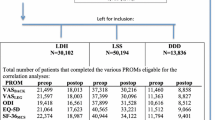Abstract
Outcome scores are very useful tools in the field of spinal surgery as they allow us to assess a patient’s progress and the effect of various treatments. The clinical importance of a score change is not so clear. Although previous studies have looked at the minimum clinically important score change, the degree of score change varies considerably. Our study is a prospective cohort study of 193 patients undergoing discectomy, decompression and fusion procedures with minimum 2-year follow-up. We have used three standard outcome measures in common usage, the oswestry disability index (ODI), the low back outcome score (LBOS) and the visual analogue score (VAS). We have defined each of these scores according to a global measure of outcome graded by the patient as excellent, good, fair or poor. We have also graded patient perception and classified excellent and good as success and fair and poor as failure. Our results suggest that a median 24-point change in the ODI equates with a good outcome or is the minimum change needed for success. We have also found that different surgical disorders have very different minimal clinically important differences as perceived by patient perception. We found that for a discectomy a minimum 27-point change in the ODI would be classed as a success, for a decompression the change in ODI needed to class it as a success would be 16 points, whereas for a fusion the change in the ODI would be only 13 points. We believe that patient-rated global measures of outcome are of value and we have quantified them in terms of the standard outcome measures used in spinal surgery.




Similar content being viewed by others
References
Stauffer RN, Coventry MB (1972) Posterolateral lumbar spine fusion Analysis of Mayo Clinic Series. JBJS (Am) 54(6):1195–1204
Macnab I (1971) Negative disc exploration. JBJS (Am) 53A:891–903
Fairbank J, Couper J, Davies JB, O’Brien JP (1980) The oswestry low back pain disability questionnaire. Physiotherapy 66:271–273
Fairbank J, Pynsent P (2000) The oswestry disability index. Spine 25(22):2940–2953
Holt AE, Shaw NJ, Shetty A, Greenough CG (2002) The reliability of the low back outcome score for back pain. Spine 27(2):206–210
Greenough CG, Fraser RD (1992) Assessment of outcome in patients with low back pain. Spine 17:36–41
Atlas SJ, Chang Y, Kammann E et al (2000) Long-term disability and return to work among patients who have a herniated lumbar disc: the effect of disability compensation. JBJS (Am) 82(1):4–15
Findlay GF, Hall BI, Musa BS et al (1998) A 10 year follow-up of the outcome of lumbar microdiscectomy. Spine 23(10):1168–1171
Beaton DE (2000) Understanding the relevance of measured change through studies of responsiveness. Spine 25(24):3192–3199
Roland M, Fairbank J (2000) The Roland-Morris disability questionnaire and the oswestry disability questionnaire. Spine 25(24):3115–3124
Beurskens AJHM, de Vet HCW, Koke AJA (1996) Responsiveness of functional status in low back pain: a comparison of different instruments. Pain 65:71–76
Taylor SJ, Taylor AE et al (1999) Responsiveness of common outcome measures for patients with low back pain. Spine 24(17):1805–1812
Suarez-Almazor ME, Kendall C et al (2000) Use of health status measures in patients with low back pain in clinical settings. Comparison of specific, generic and preference-based instruments. Rheumatology 39:783–790
Meade T, Browne W et al (1986) Comparison of chiropractic and outpatient management of low back pain: a feasibility study. J Epidemiol Commun Health 40:12–17
Hagg O, Fritzell P, Nordwall A (2003) The clinical importance of changes in outcome scores after treatment for chronic low back pain. Eur Spine J 12(1):12–20
Author information
Authors and Affiliations
Corresponding author
Rights and permissions
About this article
Cite this article
Tafazal, S.I., Sell, P.J. Outcome scores in spinal surgery quantified: excellent, good, fair and poor in terms of patient-completed tools. Eur Spine J 15, 1653–1660 (2006). https://doi.org/10.1007/s00586-005-0028-1
Received:
Revised:
Accepted:
Published:
Issue Date:
DOI: https://doi.org/10.1007/s00586-005-0028-1




